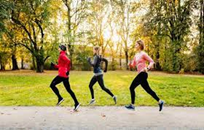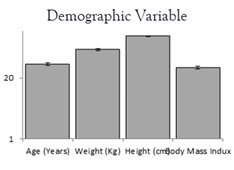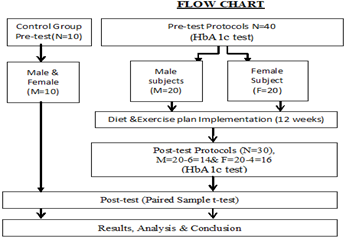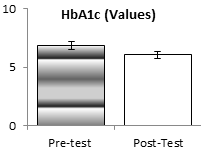Case Report
Influence of Diet and Exercise Adherence in Diabetic Cases and Its Impact on HbA1c
- Minahil Maqsood 1
- Muhamamd Sajjad Ali Gill 2*
- Irshad Nabi 2
- Muhamamd Umer 3
- HIra Shahid 3
- Muhammad Imran 4
- Rana Adil 4
- Aqib Liaqat 4
- Muhammad Sajjad 5
1Bs Scholar Department of Sports Sciences and Physical Education, University of the Punjab, Lahore, Pakistan.
2Associate Professor, Department of Sports Sciences and Physical Education, University of the Punjab, Lahore, Pakistan.
2Bs Scholar Department of Sports Sciences and Physical Education, University of the Punjab, Lahore, Pakistan.
3M. Phil Scholar Department of Sports Sciences and Physical Education, The Islamia University of Bahawalpur,Pakistan. 4M. phil Scholar Department of Sports Sciences and Physical Education, The University of the Lahore Pakistan.
5MS Scholar Department of Sports Sciences and Physical Education, University of the Punjab, Lahore, Pakistan.
*Corresponding Author: Muhamamd Sajjad Ali Gill,Associate Professor, Department of Sports Sciences and Physical Education, University of the Punjab, Lahore, Pakistan.
Citation: M. Maqsood, S.A.G. Muhamamd, I. Nabi, M. Umer, H. Shahid, et al. (2024). Influence of Diet and Exercise Adherence in Diabetic Cases and Its Impact on HbA1c, International Journal of Medical Case Reports and Reviews, BioRes Scientia Publishers. 3(1):1-9. DOI: 10.59657/2837-8172.brs.24.037
Copyright: © 2024 Muhamamd Sajjad Ali Gill, this is an open-access article distributed under the terms of the Creative Commons Attribution License, which permits unrestricted use, distribution, and reproduction in any medium, provided the original author and source are credited.
Received: November 23, 2023 | Accepted: December 04, 2023 | Published: January 08, 2024
Abstract
In a current Cross-sectional experimental study, it was observed that the impact of diet & exercise and healthy life adherence in mature diabetes cases and their influence on Glycated Hemoglobin (HbA1c, Average Glucose). The diabetic patients (Male and female) were anatomized in relation to adherence & suggested a diet with exercise plans that control the adverse effect of producing less insulin. A sample of 30 subjects, 30-50 years were selected randomly from 3 major hospitals (Jinnah, Mayo & Services) and some private laboratories. A group of (N=10) normal control subjects were also selected for further comparison. The HbA1c test has been taken before and after the implementation of the 12-week diet and exercise plan. This study utilized a simple random sampling technique and normality was checked through the Shapiro-Wilk test. The data was analyzed through SPSS-22, paired sample t-test was utilized for further comparison. The lower HbA1c values, indicating bettered diabetes operation. These results clearly depicted that it controlled the worse effects of sugar patients, which also emphasizes the significance of adherence in achieving optimal glycemic control. The result also concluded that a balanced diet and a combination of exercises control the glycemic patients efficiently and effectively.
Keywords: diabetes; adherence; glycemic and hba1c values
Introduction
One of the leading problems in disease in around the world is Diabetes mellitus, which has become principal health problem in sports as well (Qi et al., 2012; Li et al; 2013; Abbas et al., 2021). Due to development in socio-economic factors, the daily routine, changes in dietary habits, aging and sedentary life style have manifested into significant rise in number of patients suffering from diabetes mellitus, hypertension, various musculoskeletal disorders resulted rise in obesity (Zimmetet al; 2001; Sena et al., 2010; Li et al; 2013; Habib and Durrani, 2018; Gill, Bilal and Akhtar, 2023). Diabetes mellitus is a complex and habitual complaint defined by high blood sugar situations, and it poses considerable public health challenges around the world about 3000 years ago by the ancient Egyptians (Ahmed, 2002). Most probably, the Type 2 diabetes mellitus is considered to be one of the most common diseases globally and the threat of serious consequences increases the significance of applicable operation measures (American Diabetes Association, 2021).
Figure 1: Physical activity
Many studies work on dietary pattern which improved the glycemic level and cardiovascular risk factors showed significant from other humans (Qi et al., 2012; Whiteley, Benton, Matriarchy, and Luscombe Marsh, 2023). Furthermore, physical activity not only improves the postural status but also acknowledge to disease awareness and behavior as well to attain better self-management on HbA1c (Habib and Durrani, 2015; Christensen, Valentiner, Petersen, and Langberg, 2016). In the phase of rehabilitation mostly athletes do face the imbalance of HbA1c, but a comprehensive cardiovascular, resistance training and proper medicine helped to get the baseline values efficiently (Qi et al., 2012; Gill et al., 2022; Shaji, 2023). Stretching also played an important role in improved the blood sugar consumption as it performed slow and controlled moments which impacted contact and relaxation on muscles results in consumption of blood sugar as a primary source thus, better performance in body functionality, in addition as it improved the body ability to work efficiently in daily activities and sports (Conway, C.M. and Kelechi, 2017; Gill, Bilal & Maqsood, 2023).
Figure 2: Healthy food choices
In case of swear sports injuries the athletes HbA1c value increased as they are on bed rest and nor taking balance diet for a longer period of time resulted in overweight category and sometimes lead to obese (Abbas et al., 2021) In rehabilitation phase which is also vitals segment of the recovery phase come over this imbalance phenomena (Gill et al., 2022; Gill et al., 2023). It was not only related to subject disparity diet but it also affected the pregnant women metabolism as it prevented through physical activity at lighter mode (Boath et al., 2023). The other socioeconomically factors (e.g Income, education, employment status, and access to healthcare services) are all characteristics which have a substantial impact on diabetic cases' capability to follow suggested food and exertion routines as highlighted by the ("WHO, 2020; www.who.int/health-topics/diabetes). A number of cross-sectional studies observed that imbalance diet and periodontal health were inconsistent in diabetes persons (Ayoobi et al., 2023; Yadegar et al., 2023). People with lower socioeconomic position constantly encounter challenges similar as a lack of access to nutritive foods, lower openings for physical exertion, and a lack of healthcare services (Xu et al., 2023). Diet and proper exercise adherence resulted in salutary and an exercise recommendation was estimated using the diabetic tone operation (Chen and Carbone (2017). The gyrated hemoglobin (HbA1c) values serve as an important index of long-term blood sugar control. Adherence to food and exertion recommendations in line with WHO's (2020), findings had a direct brunt on HbA1c situations, demonstrating a clear link between life choices and physiological consequences HbA1c situations (Qi et al., 2013; Xu et al., 2023). Glycated hemoglobin (HbA1c) situations were measured as a clinical index of long-term glycemic control (Young et al., 2023). The figure 1 and 2 shows the physical activity
Objectives
Check the effect of balance & appropriate diet effect on diabetic patients. To observe the influence of proper & comprehensive exercise plan on diabetic patients.
Research Question
The balance diet and daily exercise impacted the value HbA1c (Average Glucose).
Methodology
The scholar explains the purpose of the study to the subjects and get the initial information and get the data of demographic variables N=40 subjects.
Table 1: shows the Mean ± S.D. of demographic variables of the age, Weight, Height and Body Mass Indus (BMI) of the subjects selected from 3 major and Laboratories of the Lahore, city.
| S. no | Mean±S.D |
| Age (years) | 39.43 ± 2.13 |
| Weight (Kg) | 80.16 ± 3.54 |
| Height (cm) | 156.45±3.17 |
| BMI | 33.1 ± 2.10 |
Figure 3
The Table 1 and Figure 3 Shows Mean ± S.D. of demographic variable i.e., age (years, 39.43 ± 2.13), weight (kilogram, 80.16 ±3.54), height (centimeters, 156.45 ± 3.17), along with body mass index (33.1 ± 2.10) of selected sunjects from 3 different hospitals and laboratories. In this retrospective study included 30 subjects of type 2 diabetes cases aged 30-50 selected from 3 different hospitals (Junnah, Myo & Services) and some private laboratories having confirmed diabetic issue checked through HbA1c test. The demographic variables also have been taken from the subjects. This experimental study is a cross-sectional study which assesses and checked the impact of diet & exercise effect on diabetes. A group of Normal Control (N=10) also be selected for further comparison. The pretest values have been taken initially for baseline information. The result has been checked after 3 months before and after implementation of diet & exercises plan. Before posttest protocols implemented 6 male and 4 female left the study due to their personal problems and did not take part in the post-test activity. The normal control group performed their normal activities. The remaining 30 subjects executed the posttest protocols with same condition. Principle of progression, variation and specificity has been adopted through this research. A comprehensive 12 weeks diabetic diet plan implemented balancing nutritive requirements and exercises plan executed to check the effects of these factors on HbA1c. It is shown in Table 2 and flow chart of the study is given below.
Table 2: Showed the diet and exercise plan (12 weeks) of the HbA1c subjects (male and female) along with 7th and 8th unloaded week. Diet Plan (12-week Plan for HbA1c).
| Week (1-2) | Week (3-4) | Week (5-6) | Week (7-8) | Week (9-10) | Week (11-12) | |
| Breakfast 7-8 Am | Low-fat yogurt Brown Chuck Eggs without yolk | Whole Grain Cereals with Low-fat milk Brown Chuck with Egg without yolk | Oatmeal with Sliced Bananas, Brown Chuck with vegetable Omelette |
| Low-fat yogurt Brown Chuck Eggs without yolk | Whole Grain Cereals with Low-fat milBrown Chuck with Egg without yolk |
| Mid-Day Meal 11-12PM | Apple Small serving of almonds | Fresh Fruit salad Pineapple | Small peach Grapefruit | Apple Small serving of almonds | Fresh Fruit salad Pineapple | |
| Lunch 2-3 Pm | Chickpea salad, Grilled craven with salad Whole grain roti | Grilled fish with salad Whole grain rotiChickpea salad | Brown rice with craven inside Whole grain roti Chickpea salad | Chickpea salad, Grilled craven with salad Whole grain roti | Grilled fish with salad Whole grain roti Chick pea salad | |
| Evening Meal 5-6 Pm | Interlaced biscuits with tea Pineapple clumps | Fresh fruit juice (flavorless) Fresh orange Slices Mixed unsalted nuts | Mixed unsalted nuts Tea with canderels Mixed unsalted nuts | Interlaced bisc its with tea Pineapple clumps | Fresh fruit juice(flavorless) Fresh orange slices Mixed unsalted nuts | |
| Dinner 8-9 Pm | Lentil soup with mixed vegetables Stir dinner mutton with broccoli | Ignited fish with sautéed spinach Ignited craven with sweet potato | Grilled funk inside with slide Salad Steamed leafy sap | Lentil soup with mixed vegetables Stir dinner mutton with broccoli | Ignited fish with sautéed spinach Ignited cravn with sweet Potato | |
| Exercise Plan (12-week Plan for HbA1c) | ||||||
| Morning session | Light Walk with (50-70) % intensity Full body stretching | Body weight exercises Upper body stretching | Brist walks with (50-70) %intensity | UNLOADIG WEEK | Body weight exercise & Brist walks | Walk with 80% Intensity Pool recovery session |
| Evening session | Pool session Mobilization exercises | Rest | Full body stretching | Low impact cardio exercises Full Body stretching | Jogging 15 min with 60% intensity | |
Note: Warm-up and Warm-Down after every session, each session consisted up to 45 minutes
The flow chart shows the detailed activity throughout the study along with control group values as well.
Data Analysis
The HbA1c is a Glycosylated Hemoglobin value which is calculated in gram/deciliter. It low, normal, pre-diabetes and diabetic values have been shown in the following table 3 given below:
Table 3:Showed the different values of HbA1c values along with their range. HbA1c Values Table 3
| S.NO | Glycosylated Hemoglobin Values (mg/dl) | Opinion |
| 1 | Less than < 4> | Low |
| 2 | Range 4 - 5.7 | Normal |
| 3 | Range 5.7.6.3 | Pre- Diabetes |
| 4 | 6.4 < & above | Diabetes |
The selected subjects were passed through 12 weeks diet and exercises plan and posttest has been taken with the same protocols. The results have been showed in the following table below
Table 4: Showed the Pre-test and Post (N=30) test Values analyzed by paired sample t-test of male and female diabetic patients’ data along with difference in HbA1c values and percentage improvement.
| Subjects N=30 | HbA1c Mean ± S.D. | Difference in values | % Improvement |
| Pre-test | 6.88 ± 0.36 | 0.8 | 12% |
| Post-test | 6.08 ± 0.31 |
Figure 4
The data collected from HbA1c has been analyzed through paired sample t-test The Table 3 and Figure 4 showed the results of HbA1c pretest value 6.88 ± 0.36 and posttest value 6.08 ± 0.31, with the difference improvement at 0.8 along with 12
Discussion
The results of the HbA1c revealed that balance diet and appropriate exercise improved the functionality of insulin in the body and thus cut down the value of HbA1c. The results resembled with Li et al. (2013) & Gill, Bilal and Akhtar (2023). The study extracted that after avow grievance to athlete and stuck such problem as he did not take care of his diet and perform proper exercises sessions can be compared with Gill et al. (2022) and Gill et al. (2023). In addition, the rehabilitation phase sometimes started within few hours after acute injuries. The study also depicted that rehab plan started as soon as possible after free from pain & swelling as it resulted in a risk of overweight situations, sometimes lead to obese person which led to produce problem like HbA1c as the finding was similar with Abbas et al. (2021). The cardiovascular training also improved the performance as it reduces the HbA1c values by consuming the blood sugar level consistently; the outcome was overlap with Chen and Carbone (2017). The present study highlighted that by performing physical activity we can decrease blood sugar level. The results appeared to be similar to the finding of Habib and Durrani, 2015 and Christensen, Valentiner, Petersen, and Langberg (2016) and Shaji (2023). Moreover, the study improved the glycemic level and cardiovascular risk factors as it overlaps with the findings of Qi et al., 2012; Whiteley, Benton, Matwiejczyk, and Luscombe Marsh (2023) and Xu et al. (2023), as it decreases the of risk cardiovascular injuries efficiently. The study also revealed that static and dynamic stretching is helpful in cut down the HbA1c level. The results are compared with Gill, Bilal and Maqsood (2023) as they worked on static and dynamic stretching, but this study is about reduction of HbA1c due to blood glucose consumption through stretching. The research also helpful for pregnant women in controlling the HbA1c as it used to restrict the blood suger evel at that stage, and result was similar with the finding of Boath et al. (2023).
Conclusion
The study concluded that proper exercise and a balanced diet not only support the related person but also help to cut down health issues and enhance performance. Diabetes mellitus is one of the widespread diseases in the new era, which has stabilized through a balanced diet and exercise regularly. This study is supported the issue by facts and figures. This study is supported the issues by facts and figures. Moreover, the study revealed that devotion to diet and exercise resulted in better performance not only in social but also in physical performance as well.
References
- Abbas, K., Gill, S. A., Sherwani, R. A. K., Qazi, T., Feroz, N., Adil, R., And Shahid, H., (2021). Prevalence of Obesity and Trends of Body Mass Index in Azad Jammu and Kashmir. Journal of Pharmaceutical Research International, 33(15):69-82.
Publisher | Google Scholor - Ahmed, A. M. (2002). History of diabetes mellitus. Saudi medical journal, 23(4):373-378.
Publisher | Google Scholor - American Diabetes Association. (2021). Standards of Medical Care in Diabetes 2021. Diabetes Care, 44(1):S1-S232.
Publisher | Google Scholor - Ayoobi, F., Salari Sedigh, S., Khalili, P., Sharifi, Z., Hakimi, H., Sardari, F., and Jamali, Z. (2023). Dyslipidemia, diabetes and periodontal disease, a cross-sectional study in Rafsanjan, a region in southeast Iran. BMC Oral Health, 23(1):2-11.
Publisher | Google Scholor - Boath, A., Vale, L., Hayes, L., Allotey, J., and Heslehurst, N. (2023). Differential effects of diet and physical activity interventions in pregnancy to prevent gestational diabetes mellitus and reduce gestational weight gain by level of maternal adiposity: a protocol for an individual patient data (IPD) meta-analysis of randomized controlled trials. BMJ open, 13(3):e065335.
Publisher | Google Scholor - Chen, Q., and Carbone, E. T. (2017). Functionality, implementation, impact, and the role of health literacy in mobile phone apps for gestational diabetes: scoping review. JMIR diabetes, 2(2):e8045.
Publisher | Google Scholor - Christensen, J., Valentiner, L. S., Petersen, R. J., and Langberg, H. (2016). The effect of game-based interventions in rehabilitation of diabetics: a systematic review and meta-analysis. Telemedicine and e-Health, 22(10):789-797.
Publisher | Google Scholor - Conway, C.M. and Kelechi, T.J. (2017). Digital health for medication adherence in adult diabetes or hypertension: an integrative review. JMIR diabetes, 2(2):e8030.
Publisher | Google Scholor - Gill, S. A., Bilal, M., and Akhtar, M. S. (2023). Effects of Covid-19 (OBESITY): Result of Imbalance Nutrition and Physical Inactivity during Covid-19 (Athletes and Non-Athletes). Human Nature Journal of Social Sciences, 4(2):245-253.
Publisher | Google Scholor - Gill, S. A., Bilal, M., and Maqsood, M. (2023). Effects of Stretching Exercises on Cricket Wicket Keeper Performance and Reduction of Injury Rate. Human Nature Journal of Social Sciences, 4(2):260-268.
Publisher | Google Scholor - Habib, F. and Durrani, A.M. (2015). Self-care behavior and well-being of diabetic patients. Indian Journal of Health & Wellbeing, 6(12).
Publisher | Google Scholor - Habib, F. and Durrani, A.M. (2018). Effect of Age and Socio-Economic Status on Compliance among Type 2 Diabetic Patients. Current Exploration in Diabetes & rotundity Journal, 7(3):3-7.
Publisher | Google Scholor - Li, M. Z., Su, L., Liang, B. Y., Tan, J. J., Chen, Q., Long, J. X., and Gu, L. (2013). Trends in prevalence, awareness, treatment, and control of diabetes mellitus in mainland China from 1979 to 2012. International journal of endocrinology,1-15.
Publisher | Google Scholor - Qi, Q., Meigs, J. B., Rexrode, K. M., Hu, F. B., and Qi, L. (2013). Diabetes genetic predisposition score and cardiovascular complications among patients with type 2 diabetes. Diabetes care, 36(3):737-739.
Publisher | Google Scholor - Sena, C. M., Bento, C. F., Pereira, P., & Seiça, R. (2010). Diabetes mellitus: new challenges and innovative therapies. EPMA Journal, 1:138-163.
Publisher | Google Scholor - Shaji, S. P. (2023). CARDIAC REHABILITATION: THE VITAL ROLE OF NURSES IN CARDIOTHORACIC PATIENT RECOVERY EPRA. International Journal of Multidisciplinary Research (IJMR), 9(9):1-4.
Publisher | Google Scholor - Whiteley, C., Benton, F., Matwiejczyk, L., and Luscombe-Marsh, N. (2023). Determining dietary patterns to recommend for type 2 diabetes: an umbrella review. Nutrients, 15(4):2-18.
Publisher | Google Scholor - WHO. (2020). Diabetes.
Publisher | Google Scholor - Xu, X., Yang, W., Deng, Y., Liu, L., Zhang, X., Long, C., and Wu, X. (2023). Association of socioeconomic status with glycated hemoglobin level and risk factors for diabetic retinopathy: a cross-sectional study in Sichuan, western China. BMJ open, 13(2): e067475.
Publisher | Google Scholor - Yadegar, A., Mohammadi, F., Rabizadeh, S., Meysamie, A., Nabipoorashrafi, S. A., Seyedi, S. A.,and Nakhjavani, M. (2023). Decreasing trend of blood lipid profile in type 2 diabetes: Not a promising change in HDL-C, a serial cross-sectional study. Plos one, 18(10):e0293410.
Publisher | Google Scholor - Young, K. G., McGovern, A. P., Barroso, I., Hattersley, A. T., Jones, A. G., Shields, B. M., and Dennis, J. M. (2023). The impact of population-level HbA1c screening on reducing diabetes diagnostic delay in middle-aged adults: a UK Biobank analysis. Diabetology, 66(2): 300-309.
Publisher | Google Scholor - Zimmet, P., Alberti, K. G. M. M., and Shaw, J. (2001). Global and societal implications of the diabetes epidemic. Nature, 414(6865):782-787.
Publisher | Google Scholor
















